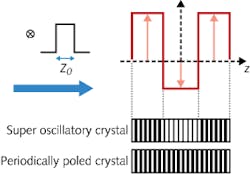Nonlinear Optics: Nonlinear crystal does supernarrow-linewidth frequency conversion
Frequency conversion of laser light—for example, second-harmonic generation (SHG)—is a very common application for nonlinear optical crystals. Many applications in optical communications and scientific research require very narrow spectral linewidths; conventional knowledge says that the spectral width of frequency-converted light is inversely proportional to the length of the nonlinear crystal, which means that narrow linewidths require long crystals—sometimes longer than can be fabricated.
Roei Remez and Ady Arie of Tel Aviv University (Tel Aviv, Israel) have overcome this limitation, allowing smaller nonlinear crystals to be used. The two researchers have fabricated a “supernarrow” frequency doubler to prove their approach.
The technique takes advantage of a phenomenon called super-oscillation, in which a band-limited function oscillates faster than its highest Fourier component. Super-oscillation can be activated in a nonlinear crystal by modulating its quadratic nonlinear coefficient in a periodic manner to achieve quasiphase-matched interaction.
In theory, the central spectral lobe of the frequency-converted optical output can be made as small as desired (although in practice, there are limits). The researchers note that there is a Fourier-transform relation between the nonlinearity of the crystal as a function of interaction length and the frequency-conversion efficiency of the crystal as a function of phase mismatch.
Modified periodically poled crystal
The resulting super-oscillatory crystal is a modification of a periodically poled crystal in which the central section of the crystal along the optical axis has a different duty cycle than the two peripheral sections.
The researchers created a computer simulation of two versions of a potassium titanyl phosphate (KTP) nonlinear medium for frequency-doubling light at a 1550 nm wavelength: a 10 mm periodically poled crystal and a super-narrow design. The result showed that the supernarrow design had a central lobe 58% narrower than that for the periodically poled design.
Next, they fabricated the supernarrow version of the crystal, designed for frequency-doubling 1550 nm pump light, with both the pump and single harmonic polarized along the crystal’s z direction. The 10 mm crystal had three sections with a central poling period of 24.7 μm; the center had a duty cycle of 0.5 and the two outer sections had a duty cycle of 0.26. As a control, the researchers created a standard periodically poled channel with a duty cycle of 0.5 parallel to the experimental channel in the same crystal.
The crystal was temperature-controlled at 50°C; the pump beam was focused to a 62 μm waist in the crystal and modulated with a chopper. The second-harmonic output was measured with a silicon photodiode.
The resulting super-oscillation spectral bandwidth of 1.1 nm was 39% smaller than the 1.8 nm width of the sinc side lobes in the control periodically poled channel, and was also 69% narrower than the 3.6 nm width of the central lobe in the control.
The conversion efficiency for the super-oscillation crystal, determined by measuring the second harmonic power as a function of the pump power, was 3.4 × 10-4%/W at the optimal wavelength of 1550.8 nm. The control (periodically poled) channel had a peak efficiency of 4.3 × 10-2%/W and a first side lobe efficiency of 2.5 × 10-3%/W. The researchers also describe a way to move the side lobes produced by the new crystal away from the super-oscillation region, which can help to keep a not-very-narrow input signal clear.
The super-oscillating crystal approach may be useful for nonlinear processing and nonlinear filtering of optical signals in optical communications, say the researchers, as well as for spectroscopy and quantum-information applications. Other types of nonlinear interactions that require phase-matching could also benefit, such as nondegenerate four-wave mixing. The crystal could even enhance coupling between a free-space beam and either a waveguide mode or a surface-plasmon-polariton wave.
REFERENCE
1. R. Remez and A. Arie, Optica, 2, 5, 472 (2015); http://dx.doi.org/10.1364/OPTICA.2.000472.

John Wallace | Senior Technical Editor (1998-2022)
John Wallace was with Laser Focus World for nearly 25 years, retiring in late June 2022. He obtained a bachelor's degree in mechanical engineering and physics at Rutgers University and a master's in optical engineering at the University of Rochester. Before becoming an editor, John worked as an engineer at RCA, Exxon, Eastman Kodak, and GCA Corporation.
